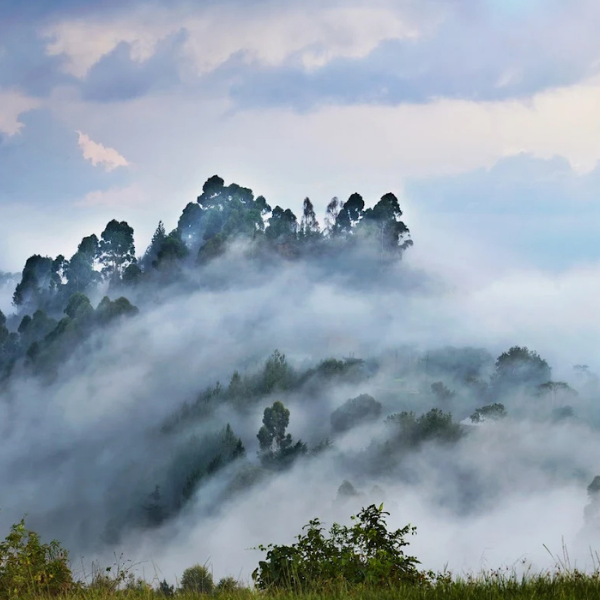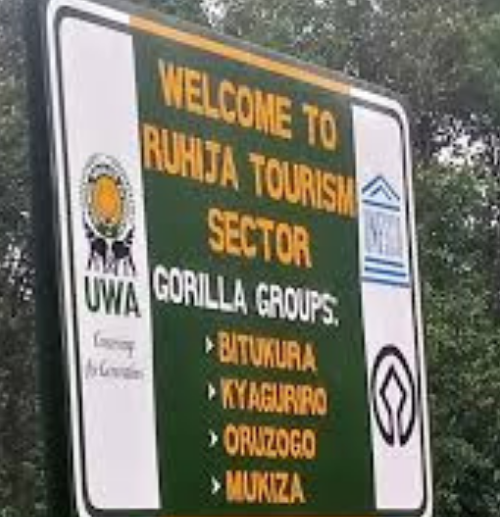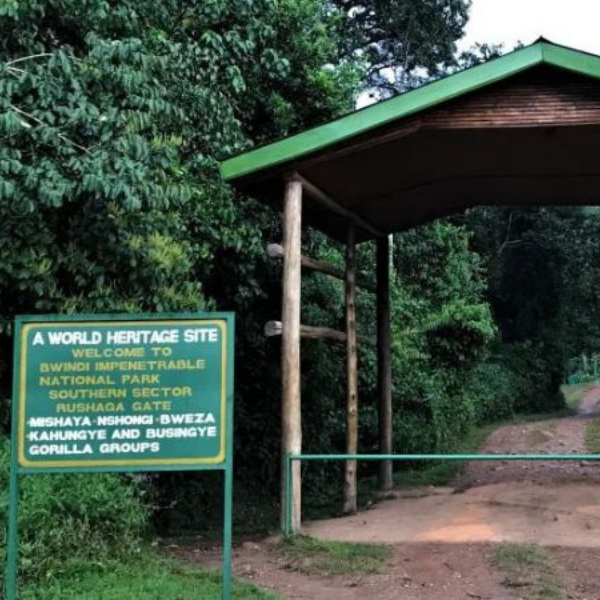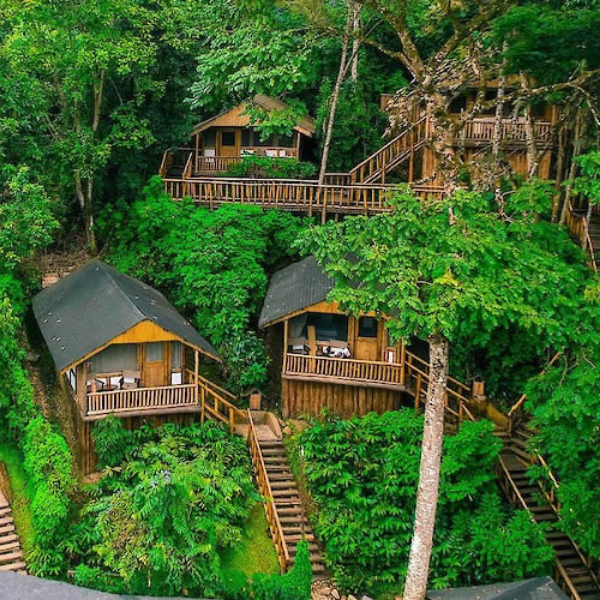Gorilla Trekking in Uganda
Home » Activities & Experiences » Activities in Uganda » Gorilla Trekking in Uganda

Experience Traditions That Tell Uganda’s Gorilla Trekking Story
Gorilla trekking in Uganda is a once-in-a-lifetime adventure that offers an unforgettable encounter with the majestic mountain gorillas in their natural habitat. Nestled within the dense rainforests of Bwindi Impenetrable National Park and Mgahinga Gorilla National Park, this extraordinary experience draws travelers from around the world seeking a deep connection with nature and wildlife.
Uganda is home to nearly half of the world’s remaining mountain gorillas, making it one of the best and most sustainable destinations for gorilla trekking in Africa.
More information about Gorilla Trekking in Uganda.
Uganda is one of only three countries in the world where you can track mountain gorillas, and it stands out for its accessibility, affordability, and biodiversity. The country is home to over 20 habituated gorilla families, offering more trekking options and permit availability than neighboring destinations. Additionally, Uganda’s gorilla trekking permits are more affordable compared to Rwanda, making it an excellent choice for budget-conscious travelers.
Beyond the gorillas, Uganda’s national parks boast rich ecosystems and scenic landscapes—from mist-covered mountains to cascading waterfalls. When you choose Neza Expeditions, you’re choosing a well-rounded safari experience that can also include game drives, cultural visits, and boat safaris in other parts of the country. Our team helps you maximize your time in Uganda by creating multi-destination itineraries built around your gorilla trek.
The dry seasons from December to February and June to September offer the best wildlife viewing, as animals gather near water sources and the vegetation is less dense. However, Uganda’s safari opportunities are excellent year-round due to its equatorial climate.
The best time for gorilla trekking in Uganda is during the dry seasons: June to September and December to February. During these months, the forest trails are more accessible, visibility is better, and the weather is more predictable, making for a more comfortable trekking experience. However, Uganda’s equatorial climate means gorilla trekking is possible all year round, with lush vegetation offering a dramatic backdrop even during rainy months.
At Neza Expeditions, we help you plan your trip based on your availability and interests. Whether you prefer trekking during the dry season for optimal conditions or the low season for fewer crowds, our team provides honest guidance and up-to-date travel tips to ensure your adventure is smooth and rewarding.
A birdwatching trip in Uganda often starts early in the morning when bird activity is highest. Guided by expert birders, you’ll explore forests, wetlands, and open plains, using binoculars and field guides to spot and identify species. In some areas, short boat rides offer the chance to see waterbirds up close. Depending on the destination, your day may involve nature walks, drives, or canoe trips, with plenty of breaks to photograph and log sightings.
To trek gorillas in Uganda, you must obtain a permit from the Uganda Wildlife Authority (UWA). As of now, a gorilla permit costs $700 per person for foreign non-residents, $600 for foreign residents, and 250,000 UGX for East African citizens. These permits are limited and in high demand, especially during peak seasons, so early booking is essential.
Neza Expeditions takes the hassle out of the process by securing your permits as part of our tour packages. We also assist with transport arrangements, accommodation near the parks, and all necessary logistics. Our expert team ensures you get your permit confirmed in advance, giving you peace of mind and allowing you to focus on the adventure ahead.
Gorilla trekking pairs perfectly with other top attractions in Uganda. After your trek, you can explore Queen Elizabeth National Park for wildlife viewing, Murchison Falls for dramatic scenery and boat safaris, or Lake Bunyonyi for relaxation amidst breathtaking hills. This variety makes Uganda one of the most diverse safari destinations in Africa.
With Neza Expeditions, you can customize your itinerary to include game drives, chimpanzee tracking in Kibale Forest, cultural village tours, or even birdwatching in Mabamba Swamp. We design your trip to reflect your interests, timeline, and budget while delivering seamless transitions from one destination to the next.
These endangered primates are found only in the Albertine Rift, with unique adaptations to bamboo forests and a highly social lifestyle that fascinates wildlife enthusiasts.
Gorilla Trekking Destinations in Uganda
Gorilla Trekking in Bwindi Overview
Bwindi Impenetrable National Park is a UNESCO World Heritage Site and the crown jewel of gorilla trekking in Uganda. Bwindi is nestled in the mist-covered hills of southwestern Uganda, with parts in districts like Kisoro, Kabale, Kanungu, and Rukungiri. It stretches across 321 square kilometers and harbors nearly half of the world’s surviving mountain gorilla population. The forest’s name, “Bwindi,” meaning impenetrable in the local Runyakitara language, reflects its thick undergrowth, tangled vines, and towering canopy, thus being a home not only for gorillas but also for countless other species. Unlike a zoo or wildlife reserve, Gorilla trekking in Bwindi is unpredictable and adventurous because the gorillas are free-ranging, and finding them requires following experienced rangers along forest trails that wind through steep ridges, rushing streams, and dense vegetation. Come and watch a gorilla family up close, see the silverback’s dominance, the mothers’ nurturing care, and the playful antics of the infants. This profound wildlife interaction is often described as life-changing and is considered one of the most memorable experiences in Africa.
Trekking Sectors and Gorilla Families in Bwindi Impenetrable
Nkuringo Gorilla Trekking Sector
Nkuringo lies on the southern edge of Bwindi Impenetrable National Park, within Kisoro District. It is the most physically demanding sector because steep ridges and valleys dominate the terrain. Treks involve long ascents and descents, often starting from the park headquarters at Nkuringo and moving down into the valley before climbing back out to locate the gorilla families. Nkuringo gorilla trekking sector offers panoramic views of the Virunga Volcanoes and stunning vistas over the forest canopy. The Nkuringo gorilla group is among the most popular in the park, and its habituation has created very rewarding visitor interactions. This sector is also closely tied to vibrant community tourism, with opportunities to meet locals, explore traditional crafts, and enjoy cultural performances. Nkuringo is perfect for adventurous trekkers seeking a blend of tough hiking, breathtaking scenery, and memorable gorilla encounters.
Community and Cultural Tourism
Nkuringo has some of the strongest community integration within Bwindi Impenetrable National Park. Highlights include:
- Nkuringo Cultural Centre (NCC): Offers cooking lessons, weaving workshops, and traditional dance performances.
- Batwa Trail Experiences: Guided walks with Batwa elders demonstrating hunting tools, medicinal plants, and cultural rituals.
- Village Walks: Opportunities to meet local farmers, blacksmiths, and craft makers, with proceeds supporting conservation and livelihoods.
Nkuringo Gorilla sector Scenic Value
Nkuringo offers unmatched panoramic views of the Virunga Volcanoes (Muhabura, Mgahinga, and Sabinyo) as well as Lake Mutanda’s sparkling waters. These natural backdrops make Nkuringo one of the most photogenic trekking bases in Bwindi.
Gorilla Families in Nkuringo
- Nkuringo Group – The first habituated family in this sector, opened to visitors in 2004. It is large, dynamic, and among the most popular due to its long history of habitation.
- Christmas Group – A relatively newer group, named after the dominant silverback “Christmas.” It is stable and often sighted closer to the forest edge compared to Nkuringo.
- Bushaho Group – Formed after some individuals split from the Nkuringo family. It is now fully habituated and regularly tracked.
Treks in Nkuringo can take 3 to 6 hours on average, depending on gorilla movement. Gorilla permits here are equally priced at $700 per person (foreign non-residents), but demand is high, so early booking is essential. For those seeking a blend of physical adventure, breathtaking scenery, and rich cultural immersion, Nkuringo delivers one of Bwindi’s most memorable experiences.Its rugged terrain and panoramic views make every trek both demanding and unforgettable.

Nkuringo Sector highlights
- Location: Kisoro District (southern Bwindi)
- Gorilla families: Nkuringo, Christmas, Bushaho
- Trek duration: 3–6 hours, steep terrain
- Gorilla Trekking Permit
- Unique appeal: Challenging hikes, best scenic views, strong community tourism
Accessing Nkuringo Sector
- From Rwanda: Visitors often access Nkuringo through Kigali International Airport, followed by a 4–5 hour drive via the Cyanika or Katuna border
- By road: Around 10 hours from Kampala/Entebbe, or 4–5 hours from Kabale
- Closest airstrip: Kisoro Airstrip, about 1–1.5 hours’ drive to Nkuringo
Accommodation in Nkuringo
- Luxury: Clouds Mountain Gorilla Lodge (perched at 2,100m with sweeping views).
- Mid-range: Nkuringo Bwindi Gorilla Lodge.
- Budget: Community-run guesthouses and homestays

Ruhija Sector highlights
- Location: Kabale District (eastern Bwindi)
- Gorilla families: Bitukura, Oruzogo, Kyaguliro (research focus)
- Trek duration: 3–5 hours, moderate to strenuous due to altitude
- Gorilla Trekking Permit
- Unique appeal: Less crowded, birdwatching hotspot, high-altitude scenery
Accessing Ruhija Sector
Ruhija is accessible by both road and air, making it a convenient choice for travelers planning a gorilla trekking experience. By road, the sector can be reached from Kabale in about 2–3 hours or from Buhoma in approximately 3–4 hours along scenic forest drives. From Kampala or Entebbe, the journey takes around 8–9 hours via Kabale. For those preferring air travel, the nearest airstrips are Kihihi, about 2–3 hours’ drive away, and Kisoro, roughly 3–4 hours by road.
Accommodation
Mid-range: Bakiga Lodge (known for community support), Budget: Ruhija Gorilla Lodge, Ruhija Community Rest Camp, and Luxury options are more limited but can be found in nearby Buhoma or Kabale.
Ruhija Gorilla trekking Sector
Ruhija lies on the eastern edge of Bwindi Impenetrable National Park, mainly within Kabale District. It is one of the highest-altitude gorilla trekking sectors, rising to about 2,350 meters (7,700 feet) above sea level. The terrain here combines steep ridges and mist-covered valleys, creating both a challenging and scenic trekking environment. Because of its elevation and remoteness, Ruhija remains quieter than the busier sectors of Buhoma or Rushaga, making it ideal for those seeking a peaceful and less crowded adventure. The sector is a prime birding hotspot, with opportunities to spot rare Albertine Rift endemics alongside gorilla trekking. Ruhija is home to several well-known gorilla groups, and the high-altitude landscapes open to sweeping views over forested hills and distant mountains. Beyond gorillas, visitors can enjoy cultural encounters with local communities, nature walks, and opportunities to experience Bwindi’s rich biodiversity.
Gorilla Families in Ruhija
- Bitukura Group – Habituated in 2008 and named after the river near its range. Known for peaceful interactions and close bonds among members.
- Oruzogo Group – Popular for its playful juveniles and large family size, offering great photographic opportunities.
- Kyaguliro Group – Originally reserved for research purposes, but sometimes made available for trekking. It’s essential for scientific studies of gorilla behavior.
Treks in Ruhija usually take 3 to 5 hours, depending on gorilla movement. The higher altitude makes the hikes more demanding, but the cooler climate provides relief during long treks.
Community and Cultural Encounters
Community and cultural tourism enhance the gorilla trekking experience, as trekkers can participate in Bakiga community encounters that showcase traditional dances, banana brewing demonstrations, and homestead visits, revealing the customs and daily routines of the highland people. Village walks teach you more about terraced farming on Kabale’s steep hillsides, offering insight into how locals cultivate crops in this challenging terrain. Additionally, handicraft workshops run by women’s groups allow visitors to see and purchase handmade baskets, mats, and carvings, with proceeds directly supporting conservation and community livelihoods.
Scenic and Ecological Value
Ruhija holds exceptional scenic and ecological value, making it one of Bwindi’s most rewarding trekking sectors. It is a renowned hotspot for birdwatching, with rare and sought-after species such as Grauer’s broadbill, Shelley’s crimsonwing, and the dusky crimsonwing frequently spotted by enthusiasts. Thanks to its high elevation, visitors are treated to breathtaking panoramic views that stretch across the Virunga Volcanoes, the Rwenzori Mountains, and even Lake Bunyonyi on clear days. Beyond gorillas, Ruhija is also an excellent place to encounter other primates, including L’Hoest’s monkeys and the striking black-and-white colobus, further enriching the wildlife experience.
Gorilla Trekking in Rushaga Sector
Rushaga Sector, located in the southern part of Bwindi Impenetrable National Park, is the largest and most permit-rich gorilla trekking area in Uganda. It stands out as the only sector offering the exclusive Gorilla Habituation Experience, allowing visitors to spend up to four hours with semi-habituated families under the guidance of researchers, an experience not available anywhere else in Bwindi. The terrain in Rushaga is a mix of steep valleys, ridges, and thick forest cover, creating moderately challenging treks that reward visitors with both biodiversity and sweeping scenic views. Its proximity to Kisoro town makes it highly accessible, and the sector also borders Rwanda, offering seamless connections for cross-country safaris. Beyond gorillas, Rushaga’s surrounding landscapes feature beautiful sights such as Lake Mutanda and distant views of the Virunga Volcanoes, while its communities provide rich cultural encounters with the Batwa and Bakiga people, adding to its unique appeal.
Gorilla Families in Rushaga Gorilla Trekking Sector
Rushaga is home to the highest number of habituated mountain gorilla families in Bwindi, making it the most permit-abundant sector for trekkers. Currently, there are over eight fully habituated groups, along with one used for the Gorilla Habituation Experience.
- Nshongi Family – Once the largest habituated group in Bwindi with more than 30 members, Nshongi is named after the Nshongi River, where it was first sighted. It remains an important group, though it has since split into smaller units.
- Bweza Family: Originally part of the large Nshongi group, Bweza formed after a split and is now a stable family of its own, often seen in the southern forest areas.
- Kahungye Family: A large and dynamic group, Kahungye is known for frequent changes in membership and dominance struggles within the group.
- Mishaya Family: A breakaway from Nshongi, Mishaya is recognized for its resilience and adventurous nature, often moving across a wide home range.
- Busingye Family: Its name translates to “peace,” though the dominant silverback is known for strength and bold encounters, making treks to this group particularly memorable.
- Rwigi Family: A smaller group led by a silverback named Rwigi, offering more intimate trekking encounters.
- Kutu Family: A relatively new habituated group, Kutu contributes to the sector’s high permit availability.
- Bikyingi Family (Habituation Experience): This semi-habituated group is reserved for the Gorilla Habituation Experience. With researchers and trackers, visitors spend up to four hours observing the gradual process of gorillas becoming accustomed to human presence.
The abundance of families in Rushaga not only guarantees greater flexibility in securing trekking permits but also allows visitors to encounter gorilla groups of varying sizes, dynamics, and behaviors, offering a rich and diverse trekking experience
Accessing Rushaga Gorilla Trekking Sector
Rushaga can be reached from Kisoro town in about 1–2 hours by road, making it a convenient option for travelers connecting through southwestern Uganda. From Kabale, it takes about 4–5 hours by car. Those traveling from Kampala or Entebbe should expect an 8–9 hour road journey via Kabale. By air, the closest options are Kisoro Airstrip (1–2 hours’ drive) and Kihihi Airstrip (about 3–4 hours’ drive). Its southern location also makes Rushaga ideal for travelers combining Uganda and Rwanda itineraries, as it is not far from the Cyanika border post.
Community and Cultural Tourism in Rushaga
Strong community tourism initiatives, give visitors a chance to engage with the Batwa (pygmy) people who once lived in Bwindi Forest. Guided cultural trails include storytelling, traditional music and dance, and demonstrations of hunting and gathering skills. Visitors also tour surrounding villages to learn about local farming practices, traditional brewing, and crafts such as weaving and wood carving.

Rushaga Sector highlights
- Largest Number of Gorilla Families – Rushaga has more habituated gorilla groups than any other sector in Bwindi
- Exclusive Gorilla Habituation Experience – It is the only sector in Bwindi where visitors can spend up to four hours with semi-habituated gorillas under researcher guidance.
- Easily combined with visits to Lake Mutanda, Mgahinga Gorilla National Park, and the Virunga Volcanoes; also close to the Rwanda border.
- Gorilla Trekking Permit
- Challenging but Rewarding Terrain – The landscape features steep valleys, ridges, and dense forest, making treks moderately tough but incredibly scenic.
Accommodation in Rushaga
Rushaga has a growing number of safari lodges and camps to suit all budgets. Options range from luxury lodges such as Four Gorillas Lodge and Chameleon Hill Lodge (overlooking Lake Mutanda), to mid-range choices like Ichumbi Gorilla Lodge and Rushaga Gorilla Camp, and budget-friendly accommodations including community-run guesthouses and bandas. Staying within or near the sector ensures early starts for trekking while also supporting local businesses.
Scenic and Ecological Value
Dramatic ridges, steep valleys, and dense montane forest characterize Rushaga’s landscapes. On clear days, trekkers are rewarded with expansive views of the Virunga Volcanoes across the Uganda-Rwanda-Congo border and the beautiful waters of Lake Mutanda nearby. The sector is rich in biodiversity, with forest trails often revealing sightings of primates such as vervet monkeys, black-and-white colobus, and grey-cheeked mangabeys, along with a wide range of bird species, including the Rwenzori turaco and crowned hornbill.

Key Highlights in Buhoma
- Five Gorilla Families
- Rich Cultural Tourism
- Most Accessible Sector
- Gentle Terrain – Less steep compared to Nkuringo or Rushaga
- Buhoma is the first sector in Bwindi opened to gorilla tourism in 1993 with the habituation of the Mubare family.
- Biodiversity Hotspot – Excellent birdwatching and primates like colobus and L’Hoest’s monkeys.
Accessibility
Buhoma is the most accessible trekking sector in Bwindi. From Kampala or Entebbe, the drive takes about 8–9 hours via Mbarara and Kabale. From Queen Elizabeth National Park (Ishasha sector), the journey is only about 2–3 hours, making it easy to combine gorilla trekking with wildlife safaris. By air, visitors can fly to Kihihi Airstrip (about 1–2 hours by road to Buhoma) or Ishasha Airstrip (closer if coming via Queen Elizabeth). Its location at the northern entry of Bwindi makes it the gateway sector for many visitors.
Scenic & Ecological Value
From Kampala or Entebbe, the drive takes about 8–9 hours via Mbarara and Kabale. From Queen Elizabeth National Park (Ishasha sector), the journey is only about 2–3 hours, making it easy to combine gorilla trekking with wildlife safaris. By air, visitors can fly to Kihihi Airstrip (about 1–2 hours by road to Buhoma) or Ishasha Airstrip (closer if coming via Queen Elizabeth). Its location at the northern entry of Bwindi makes it the gateway sector for many visitors.
Buhoma Sector
Buhoma Sector, located in the north of Bwindi Impenetrable National Park, is the oldest and most famous gorilla trekking area in Uganda. It was the first sector to open for gorilla tourism in 1993, with the habituation of the Mubare family, the pioneer group for trekking in Bwindi. Buhoma’s popularity stems from its accessibility; it is the easiest sector to reach from Kampala, Entebbe, and Queen Elizabeth National Park, making it a favored choice for first-time visitors. The terrain here is gentler compared to the steep trails of Nkuringo, featuring forested hills, rivers, and more manageable trekking paths. Beyond gorillas, Buhoma is a hub for birdwatching, forest walks, and cultural experiences, with a well-established tourism infrastructure that caters to both luxury and budget travelers.
Gorilla Families in Buhoma Trekking Sector
- Mubare Family: This is the first gorilla family ever habituated in Bwindi, opened to tourism in 1993. Initially led by the famous silverback Ruhondeza, the group once had 12 members but has since reduced in size, now numbering fewer individuals. Its small size makes encounters more intimate, and treks to Mubare are often shorter, ideal for visitors looking for a less strenuous hike.
- Habinyanja Family: One of Buhoma’s oldest and most adventurous groups, Habinyanja is known for its wide-ranging movements across challenging terrain. Trekkers visiting this family often embark on longer hikes, offering a good mix of physical adventure and rewarding wildlife encounters. The group has a rich history of leadership struggles, which makes its social dynamics especially interesting.
- Rushegura Family: A calmer and more stable group, Rushegura broke away from Habinyanja in 2002. It is one of the most commonly visited families in Buhoma because it often forages near the park’s edge or even wanders into community land, reducing trekking times. The group is large and lively, offering excellent opportunities for observing varied behaviors among its members.
- Katwe Family: A relatively new addition to Buhoma’s trekking options, Katwe was habituated to expand permit availability in the northern sector. The group is moderate in size, and because of its younger habituation, encounters can sometimes feel more dynamic as the gorillas adjust to human presence.
- Muyambi Family: The newest habituated family in Buhoma, Muyambi split from another group and was officially opened for trekking in 2019. It is named after the dominant silverback, Muyambi, who is strong and protective of his family. Though smaller in size, the group is energetic and provides visitors with a close look at the process of group formation and silverback leadership.
Community and Cultural Tourism
Buhoma offers some of the most developed community tourism activities in the Bwindi region. Visitors can take part in the Batwa Experience, learning about the forest-dwelling lifestyle of the indigenous Batwa people through storytelling, dance, and traditional demonstrations. The Buhoma Community Village Walk includes visits to local schools, banana plantations, herbal medicine gardens, and homesteads. Visitors can also support women’s groups that produce crafts, such as woven baskets, mats, and jewelry, with proceeds benefiting conservation and livelihoods.
Scenic and Ecological Value
The terrain in Buhoma is less steep compared to the southern sectors, making it more manageable for older travelers or those seeking moderate hikes. The forest here is rich in birdlife, with species like the African green broadbill, black bee-eater, and crowned hornbill frequently spotted. Buhoma’s trails also allow encounters with primates such as black-and-white colobus, red-tailed monkeys, and L’Hoest’s monkeys. The sector offers excellent views of the surrounding rolling hills, rivers, and tea plantations bordering the forest, creating a scenic backdrop for trekking.

